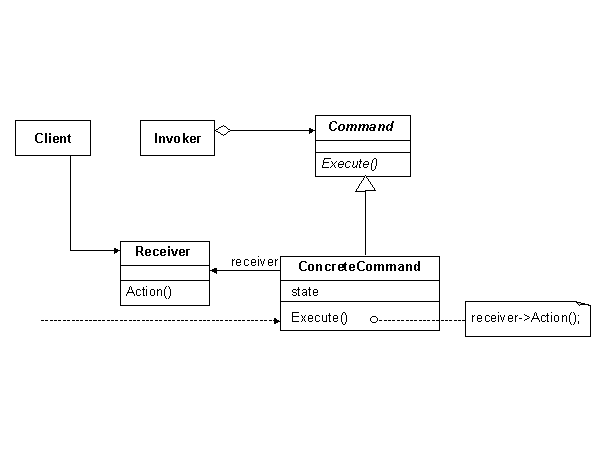Difference between revisions of "Command"
(→Introduction) |
(→Introduction) |
||
| Line 5: | Line 5: | ||
The idea behind the Command pattern is to encapsulate code that performs specific 'command-like' tasks for an application. A very important part of the command pattern is the abstract command class, which defines an interface to code to. In this class there is an execute operation. When a concrete command class is created, all of the code for one speciffic command goes into this execute operation and runs when it is called. | The idea behind the Command pattern is to encapsulate code that performs specific 'command-like' tasks for an application. A very important part of the command pattern is the abstract command class, which defines an interface to code to. In this class there is an execute operation. When a concrete command class is created, all of the code for one speciffic command goes into this execute operation and runs when it is called. | ||
| − | A good example to mention right from the beginning to help you understand the command pattern quicker is the menu bar at the top of this web browser. The command pattern may very well have been used in the design of this. Go up to the menu and click on 'File'. A bunch of options fly down (obviously). Each of these options could be implementations of the command class. New Window, for example, would call the execute operation when clicked and the code inside there would do whatever it has to do to pop open a fresh new browser. Each other option invokes it's own command(s) when clicked. That 's' is in brackets because since the command class is an object, a command can contain and execute multiple commands per single execution. This is also known as a Macro, and you can create macros with ease with the command pattern. Undo operations | + | A good example to mention right from the beginning to help you understand the command pattern quicker is the menu bar at the top of this web browser. The command pattern may very well have been used in the design of this. Go up to the menu and click on 'File'. A bunch of options fly down (obviously). Each of these options could be implementations of the command class. New Window, for example, would call the execute operation when clicked and the code inside there would do whatever it has to do to pop open a fresh new browser. Each other option invokes it's own command(s) when clicked. That 's' is in brackets because since the command class is an object, a command can contain and execute multiple commands per single execution. This is also known as a Macro, and you can create macros with ease with the command pattern. Undo / re-do operations, log files, and other commonly used commands are also easily implemented with the command pattern. |
| − | |||
| − | |||
= UML Diagram = | = UML Diagram = | ||
Revision as of 20:43, 25 March 2007
Introduction
The Command Pattern
The idea behind the Command pattern is to encapsulate code that performs specific 'command-like' tasks for an application. A very important part of the command pattern is the abstract command class, which defines an interface to code to. In this class there is an execute operation. When a concrete command class is created, all of the code for one speciffic command goes into this execute operation and runs when it is called.
A good example to mention right from the beginning to help you understand the command pattern quicker is the menu bar at the top of this web browser. The command pattern may very well have been used in the design of this. Go up to the menu and click on 'File'. A bunch of options fly down (obviously). Each of these options could be implementations of the command class. New Window, for example, would call the execute operation when clicked and the code inside there would do whatever it has to do to pop open a fresh new browser. Each other option invokes it's own command(s) when clicked. That 's' is in brackets because since the command class is an object, a command can contain and execute multiple commands per single execution. This is also known as a Macro, and you can create macros with ease with the command pattern. Undo / re-do operations, log files, and other commonly used commands are also easily implemented with the command pattern.
